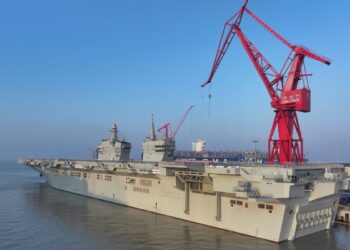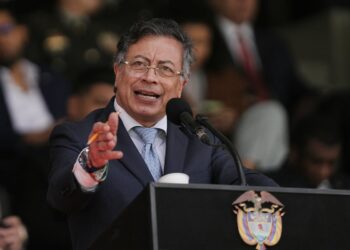**PARIS** — Swedish Defense Minister **Pål Jonson** announced that a decision regarding Sweden’s planned purchase of four frigates is expected early next year. This announcement comes after a meeting with French counterpart **Catherine Vautrin** in Stockholm. The Swedish government is currently awaiting advice from the **Swedish Defence Materiel Administration (FMV)** as they explore available options.
During their press conference, the ministers discussed various topics including the Swedish frigate program, French interest in **Saab’s GlobalEye** airborne early warning and control aircraft, and support to **Ukraine**. Vautrin noted that France expects to supply a fully equipped and armed frigate to Sweden by **2030**, which aligns with Sweden’s target for the first deliveries.
Jonson highlighted the importance of assessing available frigates that fit Sweden’s ambitious timeline. He mentioned that the FMV had completed a market survey, but a decision is still pending. The goal is to ideally acquire two frigates by **2030** and another two by **2035**. Additionally, he emphasized the significance of air-defense capabilities in the new frigates as Sweden moves toward integration with NATO’s Integrated Air and Missile Defence program.
In **May 2024**, Sweden announced a change in its plans to procure surface combatants, indicating that the new vessels would be larger than the current **Visby-class corvettes**. Sweden is open to considering off-the-shelf designs instead of solely Swedish solutions.
In **October**, France proposed the **Naval Group’s FDI frigate** to Sweden and suggested a partnership with the Swedish defense industry, particularly with Saab. This initiative offers Naval Group a renewed opportunity to sell its frigate after Norway selected the British **Type 26 frigate** over the smaller French design.
The FDI frigate, which features a strong emphasis on anti-air capabilities, incorporates the **Thales Sea Fire radar** for long-range air defense and 16 to 32 vertical-launch cells for **MBDA Aster 15 and 30 missiles**. In contrast, the Type 26 frigate is primarily designed for anti-submarine warfare.
France’s Navy received its first FDI frigate, **Amiral Ronarc’h**, in October, being the first of five vessels planned. Furthermore, the **Hellenic Navy** signed a contract earlier this month for a fourth FDI frigate, in addition to three vessels currently under construction. Vautrin mentioned that the Amiral Ronarc’h is scheduled to visit the Swedish seaport of **Göteborg** early next year.
The **Naval Group’s Defense and Intervention Frigate** measures 122 meters in length and displaces around 4,500 tons, making it smaller compared to new-generation frigates currently being developed in various countries including Spain, the United States, Italy, and Germany.
Discussions also included Saab’s GlobalEye system, which Vautrin noted is of significant interest to France as they seek to replace existing assets. **France** currently operates four **Boeing E-3F** AWACS aircraft and signed a letter of intent concerning the GlobalEye in **June**.
Vautrin expressed that France aims to develop a partnership with Sweden rather than merely being a client, applying this approach to the potential acquisition of GlobalEye.
The two ministers also discussed support for Ukraine, affirming that the letters of intent from Ukraine to acquire Saab’s Gripen and **Dassault Aviation’s Rafale** aircraft are complementary. Jonson clarified that Ukraine has expressed a clear need for a mixed fleet of around **250 aircraft**. He pointed out that while these discussions are not definite business deals yet, they carry a strong political message regarding support for Ukraine.
Jonson noted that there is a collective European interest in ensuring that Ukraine has a robust air-defense capability. Discussions on financing options also took place, with the consensus that the current situation presents a viable opportunity to utilize immobilized Russian assets to provide aid to Ukraine. Vautrin reiterated the necessity for Ukraine to be well-equipped for long-term security, especially in the context of a potential ceasefire or peace deal.













